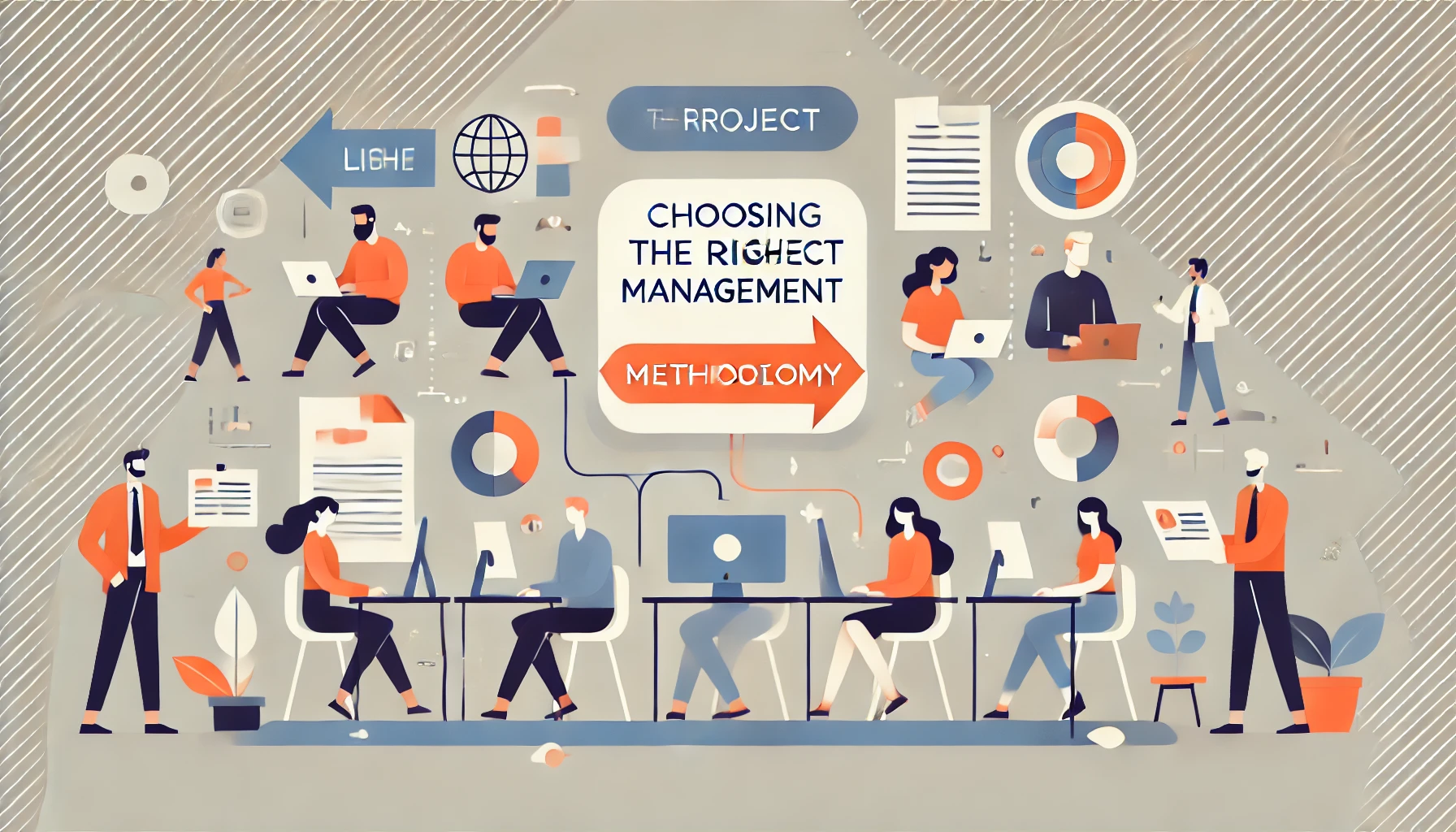Introduction
In the diverse landscape of project management, selecting the right methodology can make the difference between project success and failure. With a plethora of approaches available – from traditional Waterfall to Agile, and various hybrid models – how do you determine which methodology is best suited for your project? This comprehensive guide will walk you through the process of choosing the right project management methodology, equipping you with the knowledge to make informed decisions that align with your project goals and organisational needs.
Whether you’re a seasoned project manager or new to the field, understanding how to select the most appropriate methodology is crucial for optimising project outcomes. Let’s dive into the key considerations, popular methodologies, and practical steps for making this critical decision.
Understanding Project Management Methodologies
Before we delve into the selection process, let’s briefly review what project management methodologies are and why they matter.
A project management methodology is a set of guiding principles, processes, and practices that define how a project is planned, executed, and controlled. It provides a structured approach to managing projects, ensuring consistency and efficiency in project delivery.
Different methodologies have distinct characteristics, strengths, and weaknesses. Some of the most popular methodologies include:
- Waterfall: A linear, sequential approach
- Agile: An iterative, incremental approach
- Scrum: A specific framework within Agile
- Kanban: A visual method for managing work
- PRINCE2: A process-based method
- Lean: A methodology focused on maximising value and minimising waste
- Six Sigma: A data-driven approach to eliminating defects and reducing variability
- PMBOK: A set of standard terminology and guidelines for project management
- Hybrid: A combination of different methodologies
Each of these methodologies has its own philosophy, processes, and best practices. The key is to understand which methodology (or combination of methodologies) will best serve your project’s unique needs.
Factors to Consider When Choosing a Methodology
Selecting the right project management methodology involves careful consideration of various factors. Here are the key elements you should evaluate:
1. Project Characteristics
- Size and complexity of the project
- Duration of the project
- Clarity of requirements and goals
- Level of innovation or uniqueness required
- Project dependencies and integration needs
2. Organisational Context
- Organisational culture and readiness for change
- Existing processes and methodologies
- Available resources and expertise
- Industry standards and regulations
- Strategic alignment and business objectives
3. Stakeholder Expectations
- Client preferences and requirements
- Stakeholder involvement and communication needs
- Frequency of deliverables expected
- Level of stakeholder control desired
4. Team Dynamics
- Team size and distribution (co-located or distributed)
- Skill levels and experience of team members
- Team’s familiarity with different methodologies
- Cross-functional collaboration requirements
5. Project Constraints
- Budget limitations
- Time constraints
- Quality requirements
- Risk tolerance
- Compliance and regulatory requirements
6. Flexibility Requirements
- Likelihood of changes in project scope or requirements
- Need for adaptability during the project lifecycle
- Importance of early and frequent deliverables
7. Technology and Tools
- Available project management software and tools
- Integration with existing systems
- Data security and privacy considerations
By carefully evaluating these factors, you can narrow down your options and identify methodologies that are most likely to suit your project’s needs.
Comparing Popular Project Management Methodologies
To help you make an informed decision, let’s compare some of the most widely used project management methodologies:
Waterfall
Best for: Projects with well-defined requirements and minimal changes expected.
Pros:
- Clear structure and milestones
- Easy to understand and manage
- Well-suited for projects with fixed scope and timeline
- Comprehensive documentation
Cons:
- Limited flexibility for changes
- Delayed delivery of working product
- Potential for late discovery of issues
- May not suit projects with uncertain requirements
Agile
Best for: Projects with evolving requirements or where rapid delivery is prioritised.
Pros:
- Highly flexible and adaptive to changes
- Regular delivery of working product increments
- Continuous feedback and improvement
- Enhanced stakeholder engagement
Cons:
- Can be challenging to estimate time and cost
- Requires active stakeholder engagement
- May be less suitable for projects with fixed constraints
- Potential for scope creep if not managed properly
Scrum
Best for: Complex projects that benefit from iterative development and frequent stakeholder feedback.
Pros:
- Promotes team collaboration and self-organisation
- Regular sprint reviews and retrospectives
- Clear roles and responsibilities
- Increased transparency and adaptability
Cons:
- Requires experienced Scrum Master and Product Owner
- May be challenging for large or distributed teams
- Not ideal for projects with fixed scope and timeline
- Can be difficult to scale for very large projects
PRINCE2
Best for: Large-scale projects in organisations with a need for standardised processes.
Pros:
- Highly structured and process-driven
- Clear division of roles and responsibilities
- Scalable to projects of various sizes
- Strong focus on business justification
Cons:
- Can be bureaucratic for smaller projects
- Requires significant training and expertise
- May lack flexibility for rapidly changing environments
- Less emphasis on technical aspects of project management
Lean
Best for: Projects focused on efficiency and waste reduction.
Pros:
- Emphasizes value creation and waste elimination
- Promotes continuous improvement
- Can be applied to various types of projects
- Focuses on customer value
Cons:
- May require significant cultural change
- Can be challenging to implement in traditional organisations
- Requires ongoing commitment to maintain benefits
- May not suit all types of projects equally
Six Sigma
Best for: Projects requiring high levels of quality and consistency.
Pros:
- Data-driven approach to problem-solving
- Focuses on reducing variability and defects
- Can lead to significant cost savings
- Provides a structured improvement methodology (DMAIC)
Cons:
- Requires extensive training and expertise
- May be overly complex for simple projects
- Focuses more on existing processes than innovation
- Can be time-consuming to implement fully
Hybrid
Best for: Projects that require a balance between structure and flexibility.
Pros:
- Combines benefits of multiple methodologies
- Adaptable to different project phases or components
- Can ease transition from traditional to Agile approaches
- Allows for customisation to specific project needs
Cons:
- Requires careful planning and expertise to implement effectively
- May lead to confusion if not clearly defined
- Can be challenging to maintain consistency across projects
- Potential for ‘cherry-picking’ practices without understanding their context
Steps for Choosing the Right Methodology
Now that we’ve explored the factors to consider and compared popular methodologies, let’s outline a step-by-step process for selecting the right approach for your project:
1. Analyse Project Requirements
Start by thoroughly analysing your project’s specific requirements, constraints, and objectives. Consider the factors we discussed earlier, such as project size, complexity, timeline, and stakeholder expectations. Create a detailed project charter or brief to capture these elements.
2. Assess Organisational Capabilities
Evaluate your organisation’s current capabilities, including team skills, available resources, and cultural readiness for different methodologies. Consider any existing processes or methodologies already in use. Conduct a SWOT analysis to identify strengths and weaknesses in your organisation’s project management approach.
3. Identify Potential Methodologies
Based on your analysis, identify methodologies that could potentially fit your project’s needs. Don’t limit yourself to a single approach; consider hybrid options that combine elements from different methodologies. Create a shortlist of 2-3 methodologies that seem most suitable.
4. Evaluate Pros and Cons
For each potential methodology, evaluate the pros and cons in the context of your specific project. Consider how well each approach aligns with your project requirements and organisational capabilities. Use a decision matrix to score each methodology against your key criteria.
5. Consult Stakeholders
Involve key stakeholders in the decision-making process. Discuss the potential methodologies with team members, clients, and other relevant parties to gather their input and ensure buy-in. Consider conducting a workshop or survey to collect diverse perspectives.
6. Assess Risks and Mitigation Strategies
For each methodology under consideration, identify potential risks and develop mitigation strategies. This could include risks related to team adaptation, stakeholder acceptance, or project delivery. Ensure that your chosen methodology doesn’t introduce unmanageable risks.
7. Pilot or Phased Implementation
If possible, consider piloting the chosen methodology on a small project or phase before full implementation. This allows you to test its effectiveness and make adjustments as needed. Set clear success criteria for the pilot and evaluate results objectively.
8. Prepare for Implementation
Once you’ve selected a methodology, prepare your team and stakeholders for implementation. This may involve training, process adjustments, and communication of new practices. Develop a comprehensive implementation plan, including timelines, resources, and change management strategies.
9. Review and Adapt
After implementing the chosen methodology, regularly review its effectiveness and be prepared to make adjustments. Set up key performance indicators (KPIs) to measure the success of the methodology. Conduct periodic retrospectives to gather feedback and identify areas for improvement.
10. Continuous Learning and Improvement
Encourage a culture of continuous learning and improvement in your project management practices. Stay informed about new methodologies and best practices in the field. Consider establishing a community of practice within your organisation to share experiences and lessons learned.
Conclusion
Choosing the right project management methodology is a critical decision that can significantly impact your project’s success. By carefully considering your project’s unique characteristics, organisational context, and stakeholder needs, you can select an approach that optimises your team’s performance and delivers the best possible outcomes.
Remember, there’s no one-size-fits-all solution in project management. The key is to remain flexible and open to adapting your approach as needed. Whether you choose a traditional Waterfall approach, embrace Agile methodologies, or opt for a hybrid model, the most important factor is that your chosen methodology aligns with your project goals and enables your team to work efficiently and effectively.
As you continue to refine your project management skills, consider exploring Project Success Hub’s range of courses and resources. Our expert-led training can help you deepen your understanding of various methodologies and enhance your ability to choose and implement the right approach for each unique project you encounter.
Ready to take your project management expertise to the next level? Discover how Project Success Hub can support your professional growth and drive success in your projects!






0 Comments